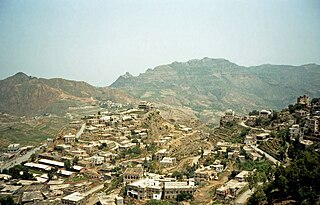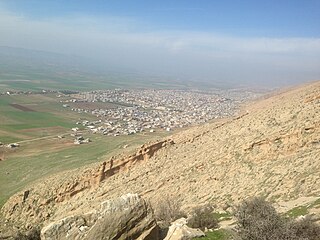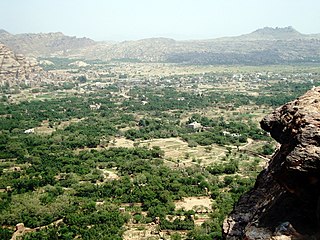
Lahij is a governorate of Yemen.

Hajjah is the capital city of Hajjah Governorate in north-western Yemen. It is located 127 kilometres northwest of Sana'a, at an elevation of about 1800 metres. As of 2003, the Hajjah City District had a population of 53,887 inhabitants.

Harir is a town and sub-district in Erbil Governorate in Kurdistan Region, Iraq. The town is located in the Shaqlawa District.

The Hashid is a tribal confederation in Yemen. It is the second or third largest – after Bakil and, depending on sources, Madh'hij – yet generally recognized as the strongest and most influential. According to medieval Yemeni genealogies, Hashid and Bakil were the sons of Jashim bin Jubran bin Nawf Bin Tuba'a bin Zayd bin Amr bin Hamdan. Member tribes of the Hashid Confederation are found primarily in the mountains in the North and Northwest of the country.

The Mehri, also known as the al-Mahrah tribe, are an Arabian ethnic group primarily inhabiting South Arabia especially in the Al-Mahra Governorate in Yemen and the island of Socotra in the Guardafui Channel. They are named after Mahra bin Haydan. They can also be found in the Sultanate of Oman, and the eastern region of the Arabian Peninsula.

Banu Hamdan is an ancient, large, and prominent Arab tribe in northern Yemen.
ʽAsr, or Qaryat ʽAsr, also transliterated as ʽAsir, is a western suburb of Sanaa, Yemen, located in Main District of Amanat al-Asimah Governorate. It is located just north of the road to al-Hudaydah, at the western edge of the Sanaa plain. The name ʽAsr is also used for the small wadi by the town, as well as the mountain nearby.
ʽAttan, also transliterated as ʽIttan and known historically as ʽAḍudān, is a village in Bani Matar District of Sanaa Governorate, Yemen. It is a short distance southwest of Sanaa, with the two being separated by a long, low hill.
Masyab, also Musayyib (مُسَيِّب), is a village in Bani Matar District of Sanaa Governorate, Yemen. It is located on the northeastern side of Jabal An-Nabi Shu'ayb.
Radman is a small village in Al Haymah Ad Dakhiliyah District of Sanaa Governorate, Yemen. It is located on the mountain of the same name, near Jabal An-Nabi Shu'ayb.

Ash Shu'ayb District is a district of the Dhale Governorate, Yemen. As of 2003, the district had a population of 38,261 inhabitants.

Shaharah is a large mountain village and seat of Shaharah District of the 'Amran Governorate, Yemen. The village "lies at 2600 metres and overlooks mountainous bulging swells to the south and shimmering hot plains to the north." It lies on top a sharp mountain of the same name, Jabal Shaharah, which is a spur of Jabal al-Ahnum, with its sides and top under extensive cultivation. The village consists of several old stone houses and a cistern. The area is noted for its limestone arch footbridge, constructed in the 17th century by a local lord to connect two villages across a deep gorge.
Bariq is a tribe from Bareq in south-west Saudi Arabia. It belongs to the ancient Al-Azd tribe which has many clans linked to it. As far as ancestry goes, Aws, Khazraj, Ghassān and Banu Khuza'a, and others all belong to Al-Azd. They were one of the tribes of Arabia during Muhammad's era.
Khamir is a small city in the 'Amran Governorate of Yemen. It is the seat of Khamir District. It is now closely associated with the tribal confederation of Hashid, although it is named after a member of the Bakil tribe and was historically mainly a Bakil town.
Khaywan is an old town and corresponding 'uzlah in Huth District of Amran Governorate, Yemen.

Wadi Zahr, also spelled Wadi Dahr, is a wadi in Yemen, located just north of Sanaa on the western edge of the Sanaa plain. It is watered by a perennial stream whose source is the large catchment area on the eastern slopes of Jabal An-Nabi Shu'ayb. The wadi proper begins near the village of Suq Bayt Naʽam and then flows eastward for about 7km through a steep-sided gorge before ending on the Sanaa plain. Wadi Zahr has fertile soil and was historically a strategic area with several forts. The main settlement in the area today is Qaryat al-Qabil.
Bayt Zud is a village in Kharif District of 'Amran Governorate, Yemen.
Rada'a is a sub-district located in Radda District, Al Bayda Governorate, Yemen. Rada'a had a population of 54714 according to the 2004 census.
Dhorm Mountain is a mountainous elevation of the Sarawat Mountains located in the Asir region of Saudi Arabia. It is distinguished by its picturesque nature and agricultural terraces. Dhorm Mountain also contains a number of historical monuments, including Mount Luqman, which is situated to the east of the villages of Dhorm, specifically at the summit of Dhorm Mountain.








